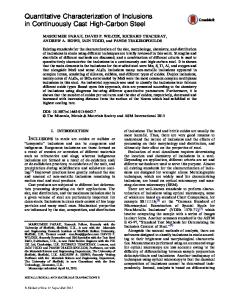On the formation of pipes and centerline segregates in continuously cast billets
- PDF / 1,755,093 Bytes
- 11 Pages / 603.28 x 783.28 pts Page_size
- 77 Downloads / 348 Views
I.
INTRODUCTION
C E N T E R L I N E porosity and macrosegregation are two of the most severe problems encountered in continuous casting of steel billets and slabs. Centerline macrosegregation is an uneven distribution of alloying elements across the centerline axis, usually with a positive segregation (concentration peak above the average concentration) of alloying elements in the center of the strand and a negative segregation (concentration less than average) on both sides. The formation of these types of defects has been discussed extensively in the literature, t~-4] Earlier it was believed that centerline macrosegregation as well as centerline porosity are caused by the fact that steel decreases in volume when solidifying due to the phase transformation from liquid to solid, i.e., solidification shrinkage. However, some years ago it was proposed that centerline macrosegregation is caused by thermal contraction of the solidified shell during solidification of the central portion of the strand. [4] This thermal contraction is caused by the temperature decrease in the solidified shell. It is difficult to verify experimentally which of these two factors is dominant during a casting operation. A distinction between the two factors can be made by analyzing the formation of the pipe in the last portion of the strand to be cast. Pipes are usually associated with ingot casting and are normally disregarded in continuous casting of steel. However, at the end of a casting sequence, a pipe is formed in the very last portion of the strand solidified. The section of the strand that contains the pipe cannot be used and thus must be remelted, resulting in a lower yield. A better understanding of the factors that influence pipe formation should lead to methods of decreasing the pipe depth and increasing the yield in continuous casting, which is beneficial from an economic viewpoint. Pipes formed during a casting operation are caused by thermal contraction as well as by solidification shrinkage. During ingot casting, contraction and volume C.-M. RAIHLE, Postgraduate Student, and H. FREDRIKSSON, Professor, are with the Department of Casting of Metals, Royal Institute of Technology, Stockholm S-100 44, Sweden. Manuscript submitted June 24, 1991. METALLURGICAL AND MATERIALS TRANSACTIONS B
change cause a decrease in liquid volume. As a consequence, the liquid surface level will decrease at the top of the ingot. During a continuous casting process, liquid is continuously supplied to the mold and compensates for the volume decrease. This situation changes at the end of a continuous casting operation, when feeding of liquid metal from tundish to mold ceases. Then the conditions are similar to those for ingot casting, and a pipe will form. The pipe is very well developed in billets, but not so pronounced in slabs. This can be attributed to differences in casting conditions and in construction of the equipment used to produce the two types of products. The discussion in this article will be limited to the casting of billets. The volume
Data Loading...











